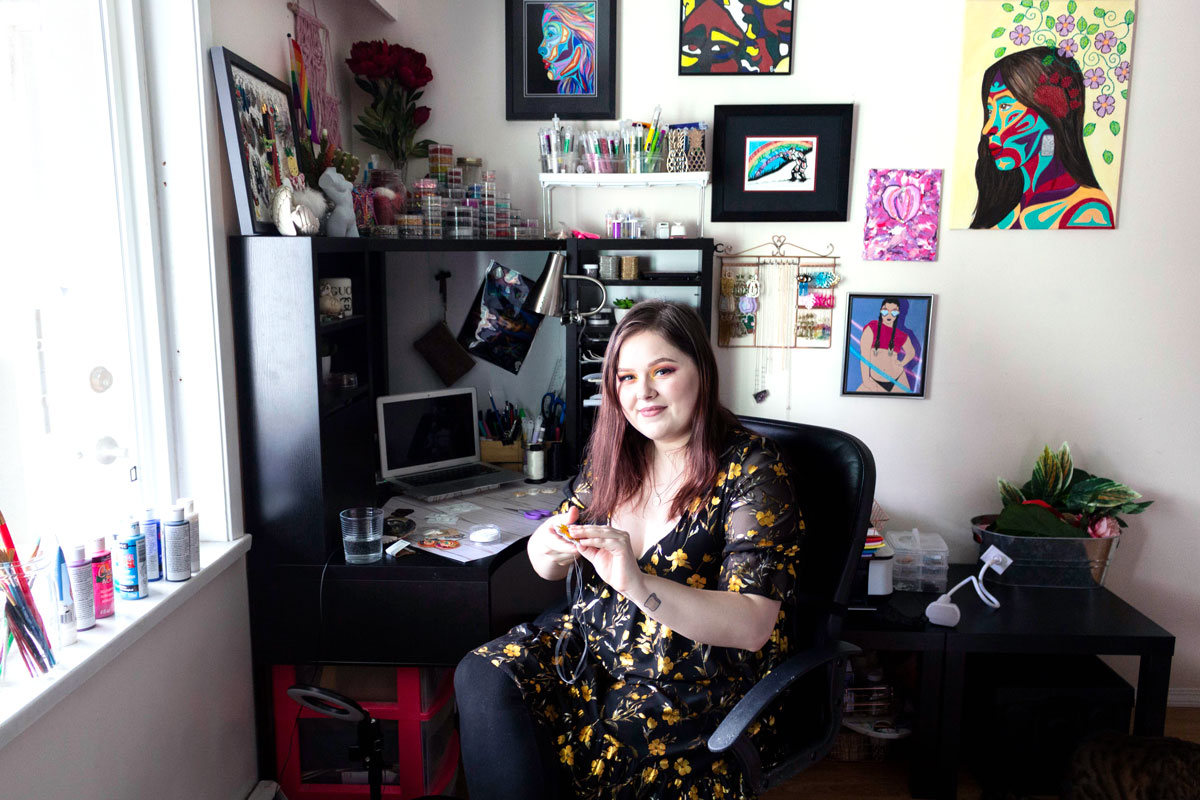“That’s one of the big steps of decolonization: what are you actually doing to give back to your community, or to the community whose land you live on? So I thought it was really important that I did something to give back. Letting people see my art, and knowing that my art can be really helpful for them feeling more connected to their roots [is one thing], but I wanted to go a little bit further than that.”
Whether there are freezing winter storms, or a third wave of the pandemic, Breanna Deis’s art is an eternal ray of sunshine.
A Two-Spirit Dene painter and beader living in Vancouver, her Instagram (@artbybreannadeis) is abundant with colourful and bold creations that take inspiration from a diverse range of sources: nature, bodies, rainbows and much more.
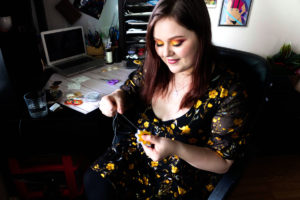
Recently Deis began beading full time and launched a website where people can easily purchase her beadwork or art prints. Although a career in art hadn’t been anticipated, over the past few months she began to sell her stunning beadwork online, and found there was a great demand for her works. Deis has also created a YouTube channel where she posts beading tutorials to provide tips for people wanting to learn how to bead.
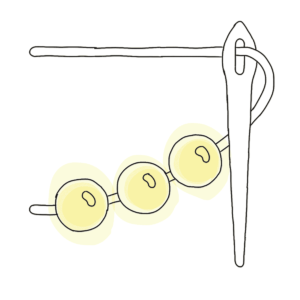
If you’re one of the many people in love with Deis’s beadwork, you have her mom to thank for encouraging her to check out Facebook beading groups at the start of the pandemic —
“I found a challenge online called ‘bead this in your style,’ and every month they release a pattern. So I started with a couple of those projects, and once I got more comfortable with what I was doing, I started posting pictures. Then it just kind of blew up online, and people started asking me to make them stuff.” And we love to see it.
Over the past few months, not only did beading become a wonderful way for Deis to express her creativity, but it also allowed her to feel more connected to her community. “Before [beading], especially in university, I was really isolated and didn’t have a lot of other people around me that were also Native,” she explained. “So it was really cool –– especially during the pandemic […] just to feel that connection to my community again. It’s really wonderful.”
Along with being an outlet to connect with her community, Deis said the online beading scene is a great learning platform, “I’m mostly self taught, so a big thing is that there’s so many resources out there. During COVID, it’s been very hard to get lessons one-on-one, or in person, so I’ve really loved it. [Also] it’s super encouraging.” She added that one of the greatest things is seeing people uplifting one another, not only by complimenting work, but by offering advice as well.
Within this amazing community, Deis has found many artists whose work she admires –– one being @lennybeadhands on TikTok, who utilizes different mediums within her work such as sequins and embroidery. She also enjoys the work of Instagram’s @nativeglam, who creates pieces with natural stones and shells, or @tonsethdesigns’s fringe work with detailed patterns.
Although there are many positives to running a business online — like access to the beading community — there are several hurdles for artists and small business owners due to algorithm/policy changes on platforms. Deis talked about the limitations that business owners like herself have dealt with lately, much of which are related to Instagram’s algorithm update, which no longer favors a chronological feed. Recently, she had gone through and unfollowed many accounts since she scarcely saw posts from businesses/friends, and due to that her account was penalized:
“[Instagram] thought I was misusing the app or something, so I couldn’t post for a week. Which is really detrimental because everytime I post, I’m usually getting people going to my website and sometimes it’s directly corresponding to sales […] the difference is crazy because my primary mode of communication with my customers is Instagram.”
The algorithm certainly is a total pain, — so a tip if you don’t want to miss posts from your favourite pages: take advantage of the “post notifications” feature for individual accounts. It will let you know every time that account posts something. Even simple engagement on social media, such as commenting and sharing, can be really beneficial to a small business! 🙂
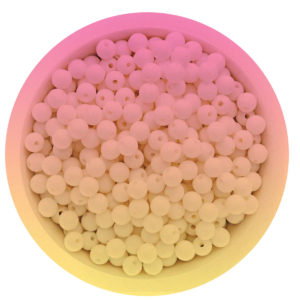
Although social media apps may not always make it easy, Deis still takes care to ensure her business has a positive impact by donating a portion of the proceeds to a new BIPOC organization every month. “A lot of the value of my products comes from me being Native,” she explained, “and if I’m gonna be taking credit for Native work […] I should be giving back to my community as well.”
“That’s one of the big steps of decolonization: what are you actually doing to give back to your community, or to the community whose land you live on? So I thought it was really important that I did something to give back. Letting people see my art, and knowing that my art can be really helpful for them feeling more connected to their roots [is one thing], but I wanted to go a little bit further than that.”
One of her favourite organizations is the Native Women’s Association of Canada (NWAC), which advocates for MMIW and for women in business. Another is the The Gord Downie & Chanie Wenjack Fund (DWF), who focus on reconciliation and providing more education in schools about Indigenous issues,
“Which I think is really important because I feel like a lot of people just don’t realize these pre-conceptions they have aren’t true, and if they were to learn differently, maybe they would act or treat us differently, and we could work towards a better community overall.”
In her work, Deis introduces new ideas and techniques, and something she has been experimenting with lately is combining her paintings and beadwork by beading directly into canvas. She’s also thinking of incorporating beading into clothing — recently she has begun styling purses with custom beaded patches that can be ordered through her website.
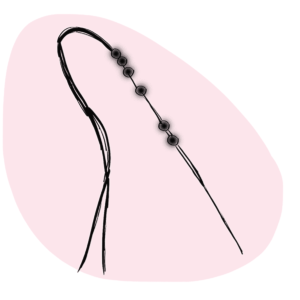
As an artist who loves to experiment with different colours and mediums, Deis explained that one of the barriers people tend to place on Indigenous creators is the expectation that they should only work with specific materials:
“We’re living in a modern world and we’re Native whether we’re wearing polyester or traditional materials.”
Through her art and donations to BIPOC charities, Deis has worked hard to combat stereotypes that are used to limit the potential of Indigenous artists. Placing value on decolonization and community, she offered some advice to anyone feeling reticent to reconnect:
“To the people that don’t feel like they’re really ‘Native enough,’ I really encourage you to […] take a look into your community and try to reconnect. Don’t worry about what anybody’s gonna say, because you are Native enough. It’s hard work to get to that place. For a lot of us. For myself specifically. I just want to encourage everyone to do that because it’s so important. It is something that’s made me feel a lot more like myself, and of course, its given me this career. I now get to be a full time artist which I never thought was a realistic dream.”
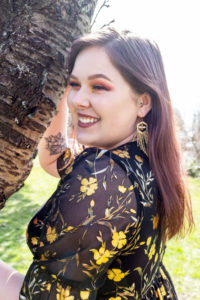
As unpredictability surrounds us, and it can become increasingly difficult to remain optimistic, it helps to know that there are people like Deis who are adamant on creating safe spaces for marginalized communities and supporting causes that create change.


